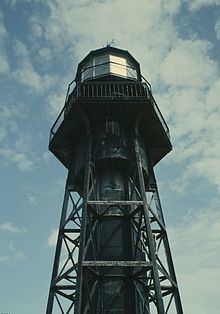Year first lit 1900 Foundation Concrete Opened 1900 Added to NRHP 22 October 1981 | Deactivated 1976 Construction Iron Automated 1973 | |
 | ||
Tower shape Skeletal with central cylinder Similar Cardona Island Light, Punta de las Figuras Light, Punta Mulas Light, Puerto Ferro Light, Guánica Light | ||
Mona Island Light, also known as Faro de la Isla de la Mona, is a historic lighthouse located on the island of Mona, Puerto Rico, in the Mona Passage between Puerto Rico and the Dominican Republic. It is the only lighthouse built of iron and steel in Puerto Rico. While some sources reported that the structure was designed by Gustav Eiffel, who also designed the Eiffel Tower in Paris, recent studies have shown that the tower was designed around 1885 by Spanish engineer Rafael Ravena.
Contents
Map of Faro de la Isla de la Mona, Mayag%C3%BCez, 00680, Puerto Rico
It is the first of two lighthouses built by the U.S government in Puerto Rico.
It was first lit in 1900 and automated in 1973. In 1976, the light was deactivated and replaced by a modern beacon. The structure has deteriorated severely since deactivation. The lighthouse is listed in "Frommer's 500 Places to See Before They Disappear" and Lighthouse Digest magazine described the condition of the lighthouse as dire: "This lighthouse has to be among the most endangered in the U.S. – along with being one of the most isolated – rusting away in the tropical heat and humidity."
History
Two sets of plans were drawn up between 1885–1886 by Spanish engineer Rafael Ravena, working for the Spanish government, for a lighthouse on the eastern side of Mona Island to help mark Mona Passage, which runs between Puerto Rico and the Dominican Republic. One set of plans called for a massive masonry structure with twenty five rooms for three keepers, families and supplies and a light with a range of 22 miles. However this was not the design that was finally used, probably to the very porous and brittle sandstone conditions of Mona Island.
The second set of plans called for an iron tower with a separate living quarters for one keeper and his family. This plan was approved in 1887, and work on the station started in the early 1890s. The lighthouse's materials were fabricated in France by Duclos & Cie. The U.S. government continued its construction after the Spanish–American War in 1898.
The lighthouse, as "Faro de la Isla de la Mona", was listed on the U.S. National Register of Historic Places in 1981.
